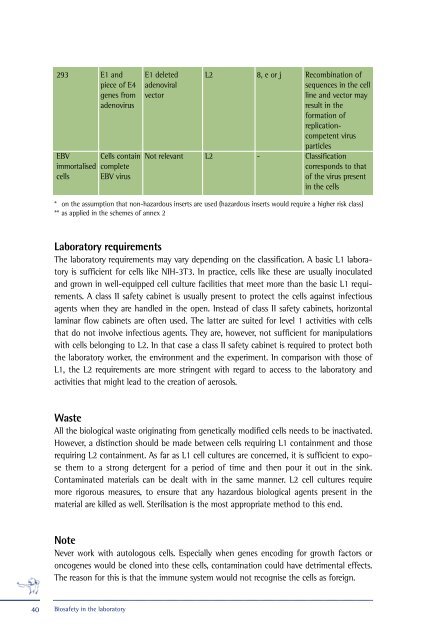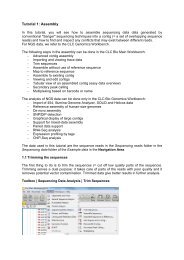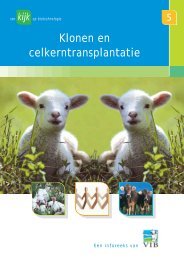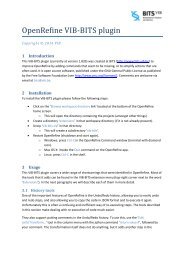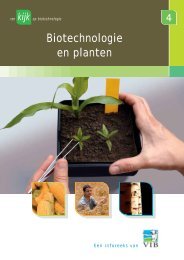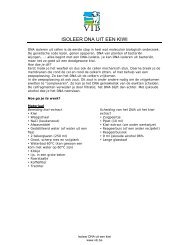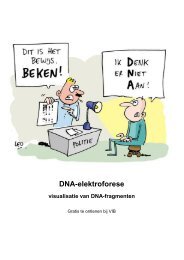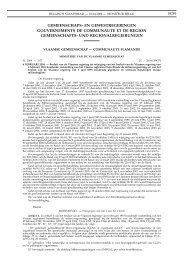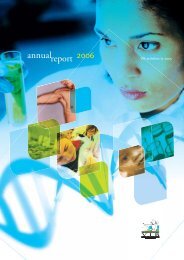Biosafety in the laboratory - VIB
Biosafety in the laboratory - VIB
Biosafety in the laboratory - VIB
You also want an ePaper? Increase the reach of your titles
YUMPU automatically turns print PDFs into web optimized ePapers that Google loves.
293 E1 and E1 deleted L2 8, e or j Recomb<strong>in</strong>ation of<br />
piece of E4 adenoviral sequences <strong>in</strong> <strong>the</strong> cell<br />
genes from vector l<strong>in</strong>e and vector may<br />
adenovirus<br />
result <strong>in</strong> <strong>the</strong><br />
formation of<br />
replicationcompetent<br />
virus<br />
particles<br />
EBV Cells conta<strong>in</strong> Not relevant L2 - Classification<br />
immortalised complete<br />
corresponds to that<br />
cells EBV virus of <strong>the</strong> virus present<br />
<strong>in</strong> <strong>the</strong> cells<br />
* on <strong>the</strong> assumption that non-hazardous <strong>in</strong>serts are used (hazardous <strong>in</strong>serts would require a higher risk class)<br />
** as applied <strong>in</strong> <strong>the</strong> schemes of annex 2<br />
Laboratory requirements<br />
The <strong>laboratory</strong> requirements may vary depend<strong>in</strong>g on <strong>the</strong> classification. A basic L1 <strong>laboratory</strong><br />
is sufficient for cells like NIH-3T3. In practice, cells like <strong>the</strong>se are usually <strong>in</strong>oculated<br />
and grown <strong>in</strong> well-equipped cell culture facilities that meet more than <strong>the</strong> basic L1 requirements.<br />
A class II safety cab<strong>in</strong>et is usually present to protect <strong>the</strong> cells aga<strong>in</strong>st <strong>in</strong>fectious<br />
agents when <strong>the</strong>y are handled <strong>in</strong> <strong>the</strong> open. Instead of class II safety cab<strong>in</strong>ets, horizontal<br />
lam<strong>in</strong>ar flow cab<strong>in</strong>ets are often used. The latter are suited for level 1 activities with cells<br />
that do not <strong>in</strong>volve <strong>in</strong>fectious agents. They are, however, not sufficient for manipulations<br />
with cells belong<strong>in</strong>g to L2. In that case a class II safety cab<strong>in</strong>et is required to protect both<br />
<strong>the</strong> <strong>laboratory</strong> worker, <strong>the</strong> environment and <strong>the</strong> experiment. In comparison with those of<br />
L1, <strong>the</strong> L2 requirements are more str<strong>in</strong>gent with regard to access to <strong>the</strong> <strong>laboratory</strong> and<br />
activities that might lead to <strong>the</strong> creation of aerosols.<br />
Waste<br />
All <strong>the</strong> biological waste orig<strong>in</strong>at<strong>in</strong>g from genetically modified cells needs to be <strong>in</strong>activated.<br />
However, a dist<strong>in</strong>ction should be made between cells requir<strong>in</strong>g L1 conta<strong>in</strong>ment and those<br />
requir<strong>in</strong>g L2 conta<strong>in</strong>ment. As far as L1 cell cultures are concerned, it is sufficient to expose<br />
<strong>the</strong>m to a strong detergent for a period of time and <strong>the</strong>n pour it out <strong>in</strong> <strong>the</strong> s<strong>in</strong>k.<br />
Contam<strong>in</strong>ated materials can be dealt with <strong>in</strong> <strong>the</strong> same manner. L2 cell cultures require<br />
more rigorous measures, to ensure that any hazardous biological agents present <strong>in</strong> <strong>the</strong><br />
material are killed as well. Sterilisation is <strong>the</strong> most appropriate method to this end.<br />
Note<br />
Never work with autologous cells. Especially when genes encod<strong>in</strong>g for growth factors or<br />
oncogenes would be cloned <strong>in</strong>to <strong>the</strong>se cells, contam<strong>in</strong>ation could have detrimental effects.<br />
The reason for this is that <strong>the</strong> immune system would not recognise <strong>the</strong> cells as foreign.<br />
40<br />
<strong>Biosafety</strong> <strong>in</strong> <strong>the</strong> <strong>laboratory</strong>


